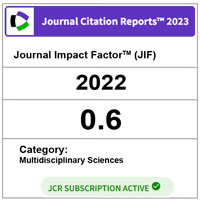Biodecolourisation of Acid Red 27 Dye by Citrobacter freundii A1 and Enterococcus casseliflavus bacterial consortium
DOI:
https://doi.org/10.11113/mjfas.v14n2.961Keywords:
Bacteria consortia, Azo dye decolourisation, Cyclic voltammetry, Irreversible reaction, Catechol degradationAbstract
The feasibility of Citrobacter freundii A1 and Enterococcus casseliflavus C1 bacterial consortium under sequential facultative anaerobic-aerobic treatment for complete dye degradation using AR-27 dyes shows 98% decolourisation and 100% COD removal after 72 hours treatment. Moreover, the UV-Vis spectroscopy and Fourier Transform Infrared (FTIR) Spectroscopic analysis confirmed that the azo linkage was cleaved after the decolourisation occurred. While, the cyclic voltammetry analysis also shows that the decolourisation of AR-27 by C. Freundii A1 and E. Casseliflavus C1 was an irreversible reaction and the detection of oxidation reaction under agitation proved the presences of AR-27 degradation process. Furthermore, the HPLC analysis has confirmed the AR-27 degradation through the decrease in catechol concentration.References
Abdul-Wahab, M. F., Chan, G. F., Yusoff, A. R. M., Rashid, N. A. A. (2012). Reduction of azo dyes by flavin reductase from Citrobacter freundii A1. J. Xenobiotics. 3(1), 2.
Anjaneya, O., Souche, S. Y., Santoshkumar, M., and Karegoudar, T. B. (2011). Decolorization of sulfonated azo dye Metanil Yellow by newly isolated bacterial strains: Bacillus sp. strain AK1 and Lysinibacillus sp. strain AK2. J. Hazard Mater. 190(1), 351-358.
Bay, H. H., Lim, C. K., Kee, T. C., Ware, I., Chan, G. F., Shahir, S. Ibrahim, Z. (2013). Decolourisation of acid orange 7 recalcitrant auto oxidation coloured by-products using an acclimatised mixed bacterial culture. Environ. Sci. Pollut. Res. 1-16.
Brownson, D. A., Banks, C. E. (2014). The Handbook of Graphene Electrochemistry. London: Springer.
Chan, G. F., Gan, H. M., Rashid, N. A. A. (2012). Genome sequence of Citrobacter sp. strain A1, a dye degrading bacterium. J. Bacteriol. 194(19): 5485-5486.
Chan, G. F., Gan, H. M., Rashid, N. A. A. (2012). Genome sequence of Enterococcus sp. strain C1, an Azo dye decolorizer. J. Bacteriol. 194(20): 5716-5717.
Chan, G. F., Rashid, N. A. A., Chua, L. S., Nasiri, R., Ikubar, M. R. M. (2012). Communal microaerophilic–aerobic biodegradation of Amaranth by novel NAR-2 bacterial consortium. Biores. Technol. 105, 48-59.
Chengalroyen, M. D., Dabbs, E. R. (2013). The microbial degradation of azo dyes: minireview. World J. Microbiol. Biotechnol. 29(3), 389-399.
Dudonné, S., Vitrac, X., Coutière, P., Woillez, M., and Mérillon, J. M. (2009). Comparative study of antioxidant properties and total phenolic content of 30 plant extracts of industrial interest using DPPH, ABTS, FRAP, SOD, and ORAC assays. J. Agriculture Food Chem. 57(5), 1768-177.
Fricke, K., Harnisch, F., Schröder, U. (2008). On the use of cyclic voltammetry for the study of anodic electron transfer in microbial fuel cells. Energy & Environmental Science, 1(1), 144-147.
Hadibarata, T., Nor, N. M. (2014). Decolorization and degradation mechanism of Amaranth by Polyporus sp. S133. Bioprocess Biosys. Engin. 37(9), 1879-1885.
Hinteregger, C., Leitner, R., Loidl, M., Ferschl, A., and Streichsbier, F. (1992). Degradation of phenol and phenolic compounds by Pseudomonas putida EKII. Applied Microbiol. Biotechnol. 37(2), 252-259.
Khouloud, M. I. B. (2013). Decolorization of two azo dyes using marine Lysobacter sp. T312D9. Malaysian J. Microbiol. 9(1), 93-102.
Lee, S. Z. (2003). Development of an enzyme assay for decolorization of azo dyes by bacterium C1. Dissertation Universiti Teknologi Malaysia.
Mohan, S. V., Babu, P. S., Srikanth, S. (2013). Azo dye remediation in periodic discontinuous batch mode operation: evaluation of metabolic shifts of the biocatalyst under aerobic, anaerobic and anoxic conditions. Sep. Puri. Technol. 118, 196-208.
Oon, Y. S., Ong, S. A., Ho, L. N., Wong, Y. S., Oon, Y. L., Lehl, H. K., Nordin, N. (2017). Microbial fuel cell operation using monoazo and diazo dyes as terminal electron acceptor for simultaneous decolourisation and bioelectricity generation. J. Hazard. Mater. 325, 170-177.
Pandey, A., Singh, P., Iyengar, L. (2007). Bacterial decolorization and degradation of azo dyes. Inter. Biodeter. Biodegrad. 59(2), 73-84.
Pearce, C. I., Lloyd, J. R., Guthrie, J. T. (2003). The removal of colour from textile wastewater using whole bacterial cells: a review. Dyes and pigments 58(3), 179-196.
Saratale, R. G., Saratale, G. D., Chang, J. S., Govindwar, S. P. (2011). Bacterial decolorization and degradation of azo dyes: a review. J. Taiwan Inst. Chem. Engin. 42(1), 138-157.
Singh, R. L., Singh, P. K., Singh, R. P. (2015). Enzymatic decolorization and degradation of azo dyes–A review. Int Biodeter Biodegrad. 104, 21-31.
Steter, J. R., Barros, W. R., Lanza, M. R., Motheo, A. J. (2014). Electrochemical and sonoelectrochemical processes applied to amaranth dye degradation. Chemosphere. 117, 200-207.
Van der Zee, F. P., Villaverde, S. (2005). Combined anaerobic–aerobic treatment of azo dyes—a short review of bioreactor studies. Water Research. 39(8), 1425-1440.
Verma, Y. (2008). Acute toxicity assessment of textile dyes and textile and dye industrial effluents using Daphnia magna bioassay. Toxicol. Indust. Health 24(7), 491-500.
Yoo, E. S., Libra, J. Adrian, L. (2001). Mechanism of decolorization of azo dyes in anaerobic mixed culture. J. Environ. Engin. 127(9), 844 – 849.







